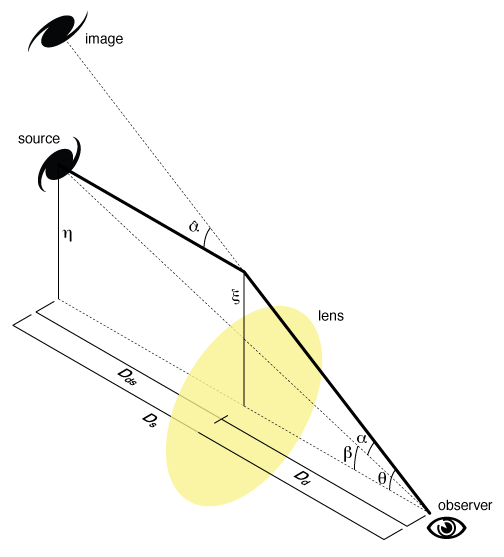As shown in the diagram on the right, the difference between the unlensed angular position  and the observed position
and the observed position  is this deflection angle, reduced by a ratio of distances, described as the lens equation
is this deflection angle, reduced by a ratio of distances, described as the lens equation
Fermat surface
There is an alternative way of deriving the lens equation, starting from the photon arrival time (Fermat surface)

where  is the time to travel an infinitesimal line element along the source-observer straight line in vacuum, which is then corrected by the factor
is the time to travel an infinitesimal line element along the source-observer straight line in vacuum, which is then corrected by the factor

to get the line element along the bended path  with a varying small pitch angle
with a varying small pitch angle  and the refraction index n for the "aether", i.e., the gravitational field. The last can be obtained from the fact that a photon travels on a null geodesic of a weakly perturbed static Minkowski universe
and the refraction index n for the "aether", i.e., the gravitational field. The last can be obtained from the fact that a photon travels on a null geodesic of a weakly perturbed static Minkowski universe

where the uneven gravitational potential  drives a changing the speed of light
drives a changing the speed of light

So the refraction index

The refraction index greater than unity because of the negative gravitational potential  .
.
Put these together and keep the leading terms we have the time arrival surface

The first term is the straight path travel time, the second term is the extra geometric path, and the third is the gravitational delay. Make the triangle approximation that  for the path between the observer and the lens, and
for the path between the observer and the lens, and  for the path between the lens and the source. The geometric delay term becomes
for the path between the lens and the source. The geometric delay term becomes

(How? There is no  on the left. Angular diameter distances don't add in a simple way, in general.) So the Fermat surface becomes
on the left. Angular diameter distances don't add in a simple way, in general.) So the Fermat surface becomes

where  is so-called dimensionless time delay, and the 2D lensing potential
is so-called dimensionless time delay, and the 2D lensing potential

The images lie at the extrema of this surface, so the variation of  with
with  is zero,
is zero,

which is the lens equation. Take the Poisson's equation for 3D potential

and we find the 2D lensing potential

Here we assumed the lens is a collection of point masses  at angular coordinates
at angular coordinates  and distances
and distances  Use
Use  for very small x we find
for very small x we find

One can compute the convergence by applying the 2D Laplacian of the 2D lensing potential

in agreement with earlier definition  as the ratio of projected density with the critical density. Here we used
as the ratio of projected density with the critical density. Here we used  and
and 
We can also confirm the previously defined reduced deflection angle

where  is the so-called Einstein angular radius of a point lens
is the so-called Einstein angular radius of a point lens  . For a single point lens at the origin we recover the standard result that there will be two images at the two solutions of the essentially quadratic equation
. For a single point lens at the origin we recover the standard result that there will be two images at the two solutions of the essentially quadratic equation

The amplification matrix can be obtained by double derivatives of the dimensionless time delay

where we have define the derivatives

which takes the meaning of convergence and shear. The amplification is the inverse of the Jacobian

where a positive  means either a maxima or a minima, and a negative
means either a maxima or a minima, and a negative  means a saddle point in the arrival surface.
means a saddle point in the arrival surface.
For a single point lens, one can show (albeit a lengthy calculation) that

So the amplification of a point lens is given by

Note A diverges for images at the Einstein radius 
In cases there are multiple point lenses plus a smooth background of (dark) particles of surface density  the time arrival surface is
the time arrival surface is

To compute the amplification, e.g., at the origin (0,0), due to identical point masses distributed at  we have to add up the total shear, and include a convergence of the smooth background,
we have to add up the total shear, and include a convergence of the smooth background,

This generally creates a network of critical curves, lines connecting image points of infinite amplification.







































































































































